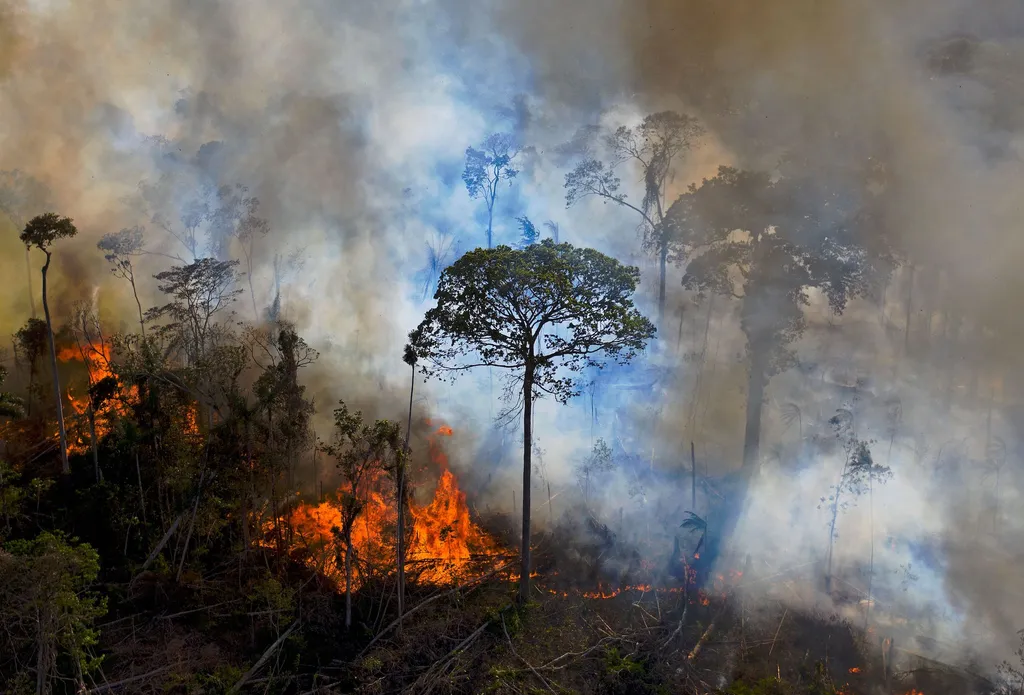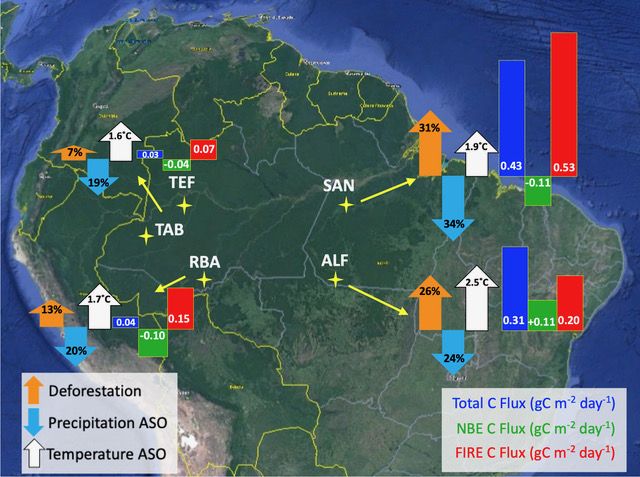아마존 열대우림은 공식적으로 흡수하는 것보다
더 많은 온실가스를 만들어 내고 있다.
By Brandon Specktor - Senior Writer 2 days ago
2일전 선임 저자 - Brandon Specktor
The rainforest was a carbon sink. Now, humans have turned it into a carbon factory.
아마존 열대우림은 공식적으로 흡수하는 것보다
더 많은 온실가스를 만들어 내고 있다.

Wildfires in the Amazon are polluting the air with greenhouse gases faster than the surviving trees can absorb it. (Image credit: Getty)
아마존 산불은 살아남은 나무들이 흡수할 수 있는 것
보다 더 빨리 온실가스로 대기를 오염시키고 있다.
(이미지 크레디트:게티)
Forests absorb huge amounts of carbon dioxide (CO2) from Earth's atmosphere, making them a key part of mitigating climate change. But humans may have already rendered the world's largest rainforest useless in — and perhaps even detrimental to — the battle against greenhouse gases, a new study finds.
숲은 지구 대기에서 엄청난 양의 이산화탄소를 흡수하여
기후변화를 완화시키는 중요한 부분을 차지한다.
그러나 새로운 연구에 따르면, 인간은 이미 세계 최대의
열대우림을 온실 가스와의 싸움에서 쓸모없게 만들었을
수도 있고, 어쩌면 온실 가스와의 싸움에 해가 될 수도
있다고 한다.
According to the study, published July 14 in the journal Nature, the Amazon rainforest is now emitting more than 1.1 billion tons (1 billion metric tons) of CO2, a greenhouse gas, a year, meaning the forest is officially releasing more carbon into the atmosphere than it is removing.
7월 14일 네이처지에 발표된 연구에 따르면 아마존 열대우림은
현재 연간 11억 톤(10억 미터톤) 이상의 온실가스를 배출하고
있으며 이는 열대우림이 공식적으로 제거되고 있는 것보다
더 많은 탄소를 대기 중으로 방출하고 있다는 것을 의미한다.
The carbon balance tipped due to "large-scale human disturbances" in the Amazon ecosystem, the researchers wrote in their study, with wildfires — many deliberately set to clear land for agriculture and industry — responsible for most of the CO2 emissions from the region. These fires also reinforce a feedback loop of warming, the team found, with more greenhouse gases contributing to longer, hotter dry seasons in the Amazon, which lead to more fires and more CO2 pollution.
연구원들은 아마존 생태계의 "대규모 인간 교란"으로 인해 탄소
균형이 첨단점이 되었다고 그들의 연구에서 썼다.
– 많은 사람들이 의도적으로 이 지역에서 발생하는 대부분의
CO2 배출에 책임이 있는 농업과 산업을 위한 땅을 개간하려고
했다.
연구팀은 이러한 화재들이 또한 온난화의 고리로 이어진 반응을
강화시키며, 더 많은 온실가스가 아마존의 길고 뜨거운 건기에
기여하고, 이는 더 많은 화재와 더 많은 CO2 오염으로 이어진다는
것을 발견했다.
The eastern Amazon, in particular — which has seen historically greater amounts of deforestation over the past 40 years — has become hotter, drier and more prone to fires than the rest of the rainforest, the researchers found. The result is greater amounts of greenhouse gas emissions from the region and fewer trees to suck up the carbon again through photosynthesis.
특히, 지난 40년 동안 역사적으로 더 많은 양의 삼림 벌채를
보아온 동부 아마존은 열대우림의 나머지 지역보다 더 덥고,
더 건조하며, 화재에 더 취약해졌다는 것을 연구원들은 발견
했다.
그 결과 광합성을 통해 다시 탄소를 흡수할 수 있는 나무와
그 지역에서 배출되는 온실가스의 양이 많아졌다.

The team's map shows how deforestation in the eastern Amazon (orange arrows) is directly linked to carbon emissions and wildfires (blue and red bars). (Image credit: Luciana Gatti, Brazilian National Institute for Space Research)
연구팀의 지도는 아마존 동부의 삼림 벌채가 탄소 배출과
산불과 어떻게 직접적으로 연관되어 있는지를 보여준다
(푸른 그리고 빨간 막대).
(이미지 크레딧: 루치아나 가티, 브라질 국립 우주 연구소)
"The first very bad news is that forest burning produces around three times more CO2 than the forest absorbs," lead study author Luciana Gatti, a researchers at Brazil's National Institute for Space Research, told The Guardian. "The second bad news is that the places where deforestation is 30% or more show carbon emissions 10 times higher than where deforestation is lower than 20%."
"첫 번째 매우 나쁜 소식은 숲을 태우는 것이 숲이 흡수하는
것보다 약 3배 더 많은 이산화탄소를 배출한다는 것입니다,"
라고 브라질의 국립 우주 연구소의 연구논문 선임 저자
루치아나 가티는 가디언지에 말했다.
"두 번째 나쁜 소식은 삼림 벌채가 30% 이상인 지역은 산림
벌채가 20% 미만인 곳보다 탄소 배출량이 10배 이상 많다는
것입니다."
In the new study, the researchers analyzed nearly 600 CO2 measurements from four sites in the Brazilian Amazon, collected with small aircraft from 2010 to 2018. The team found that, on average, fires poured about 1.6 billion tons (1.5 billion metric tons) of CO2 into the atmosphere each year, while healthy trees absorbed only about half a billion tons.
연구진은 2010년부터 2018년까지 소형 항공기로 수집한
브라질 아마존의 4개 지점 600여 개의 CO2 측정값을
분석했다.
연구팀은 매년 평균 화재로인하여 약 16억 톤의 이산화탄소가
대기 중으로 방출되는 반면 건강한 나무는 불과 약 5억 톤만을
흡수하는 것으로 밝혀냈다.
The team also found that, while the eastern Amazon has become a net source of carbon emissions, the western Amazon — which has seen much less deforestation — is neither a carbon source nor a carbon sink. There, CO2 absorption by healthy forests balances the emissions from fires, the team wrote.
연구팀은 또한 아마존 동부가 탄소 배출의 순원이 되었지만,
삼림 벌채가 훨씬 적었던 아마존 서부는 탄소 공급원도 탄소
배출원도 아니라는 것을 발견했다.
건강한 산림에 의한 CO2 흡수는 화재로부터의 배출량의 균형
을 맞춘다고 연구팀은 썼다.
The Amazon basin contains about 2.8 million square miles (7.2 million square kilometers) of jungle, representing more than half of the tropical rainforest area remaining on Earth. Limiting deforestation, and especially wildfires, is key to reversing this dangerous trend in the Amazon.
아마존 분지는 지구에 남아있는 열대 우림 지역의 절반
이상을 대표하는 약 280만 평방 마일(7백 2십만 평방
킬로미터)의 정글을 포함하고 있다.
삼림 벌채, 특히 산불의 발생을 제한하는 것이 아마존의
이 위험한 추세를 되돌리는데 핵심이다.
"Imagine if we could prohibit fires in the Amazon — [the forest] could be a carbon sink," Gatti told The Guardian. "But we are doing the opposite — we are accelerating climate change."
"우리가 아마존에서의 화재를 금지할 수 있다고 상상해 보십시오
– [숲]이 탄소 제거원이 될 수 있습니다," 라고 가티는 가디언지에
말했다.
"하지만 우리는 반대로 하고 있습니다. 우리는 기후변화를 가속화
하고 있습니다."
Originally published on Live Science.
라이브 사이언스에 원본으로 발간됨.

댓글 없음:
댓글 쓰기